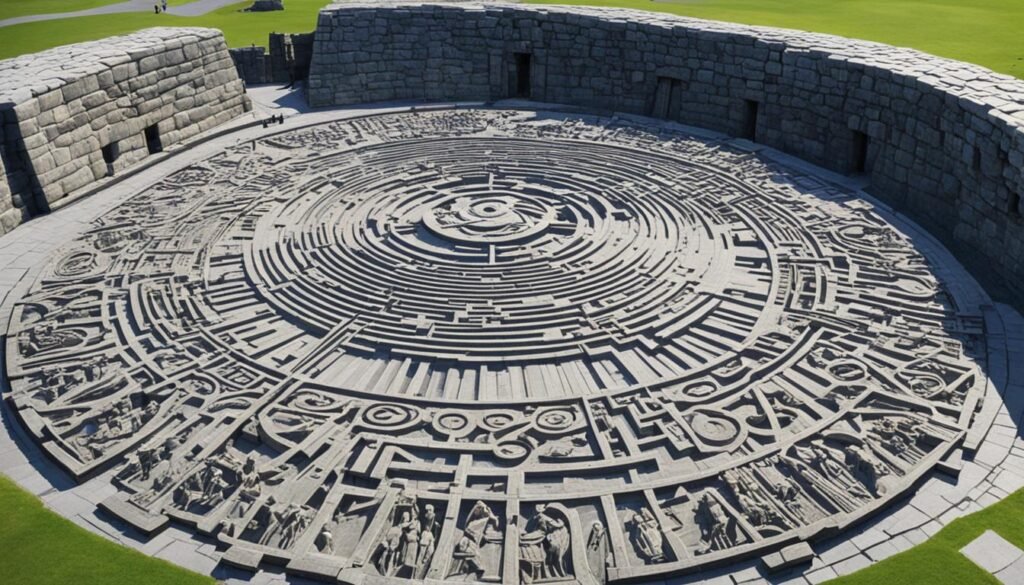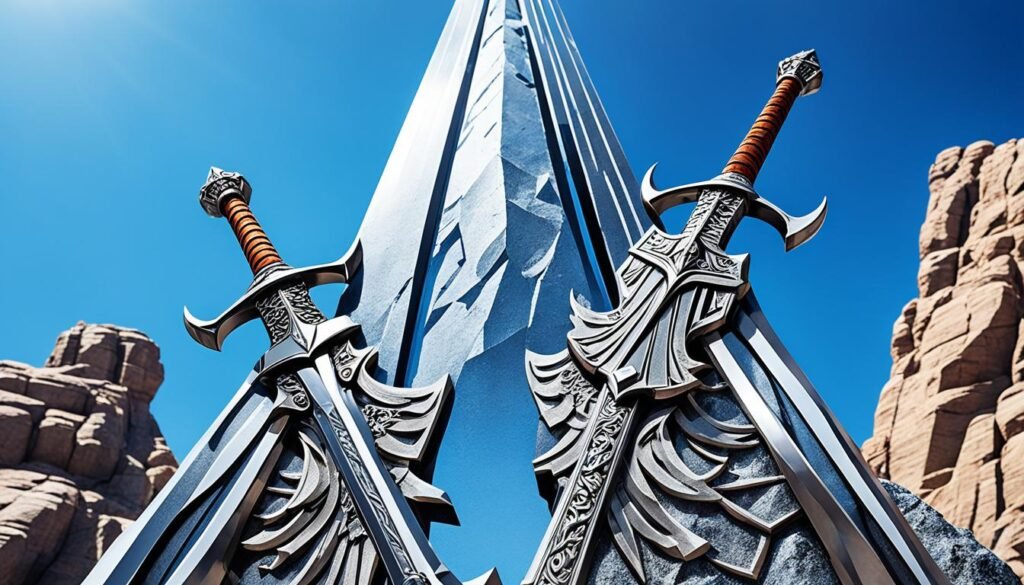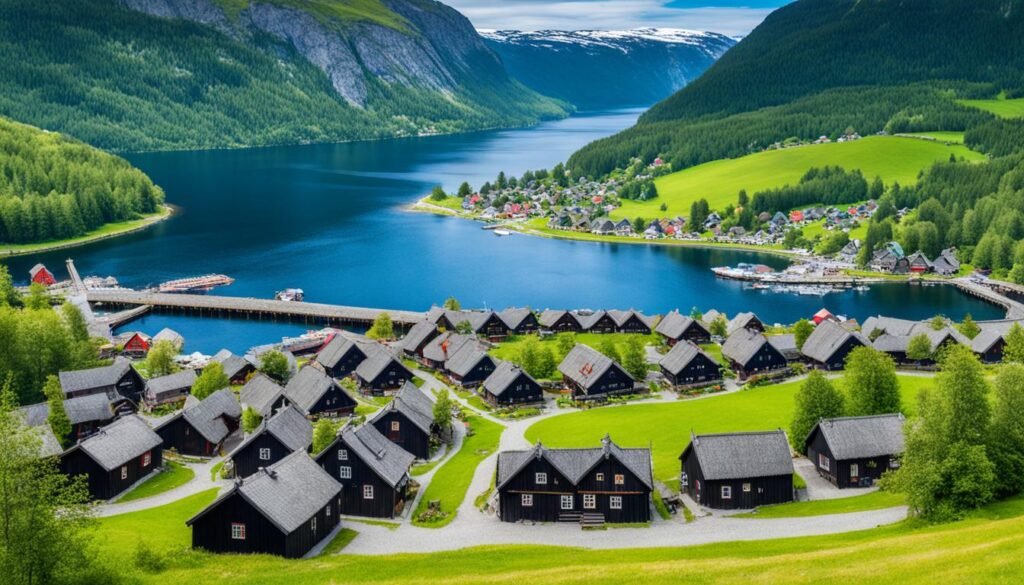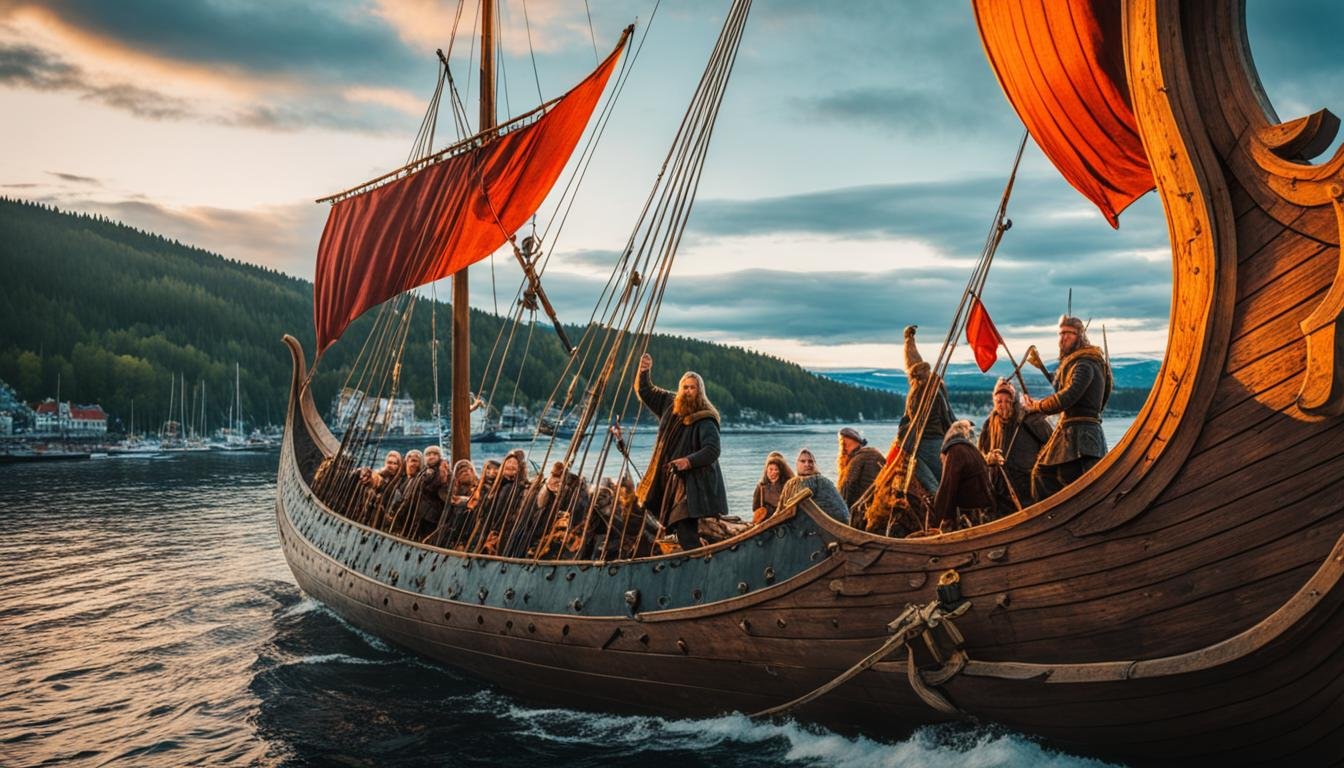Imagine stepping back in time, surrounded by the grandeur of Viking ships and the echoes of a legendary past. In Oslo, Norway, the heart of Scandinavia, the rich tapestry of Viking history and archaeology unfolds before visitors, captivating the imagination and transporting them to a bygone era. With over 200 Viking settlements discovered in the region, the city’s connection to the Norse seafaring culture is undeniable.
From the captivating Oseberg ship burial to the intricate Rune inscriptions, the cultural and historical significance of Norway’s Viking heritage is on full display. Explore the awe-inspiring Viking longhouses, uncover the mysteries of Norse mythology, and immerse yourself in the archaeological excavations that continue to shed light on this fascinating chapter of European history.
Key Takeaways
- Discover the captivating Viking history and archaeology of Oslo, Norway, the heart of Scandinavia.
- Explore the grandeur of authentic Viking ships and the rich cultural legacy left by the Norse seafaring culture.
- Uncover the mysteries of Norse mythology and delve into the archaeological excavations that continue to shed light on this fascinating era.
- Immerse yourself in the Viking experience through modern museums, interactive exhibits, and open-air villages.
- Gain a deeper understanding of the enduring influence of the Vikings on Norwegian history and the broader Scandinavian region.
Norway: Viking History and Archaeology Oslo Norway
Oslo, the capital of Norway, is a treasure trove of Viking history and archaeology. The city’s Viking heritage is showcased in several world-class museums and immersive experiences. Visitors can explore authentic Viking ships, treasures, and the rich Norse mythology that shaped the Viking civilization.
Explore Authentic Viking Ships and Treasures
The Viking Ship Museum on the Bygdøy peninsula has long been a must-visit destination for those interested in Viking archaeology. Here, visitors can admire the three best-preserved Viking ships in the world – the Oseberg, Tune, and Gokstad vessels. These remarkable artifacts, discovered in burial mounds along the Oslo fjords, offer a glimpse into the sophisticated shipbuilding techniques and seafaring prowess of the Norse people.
Modern Viking Experience Centers
In addition to the Viking Ship Museum, Oslo has recently unveiled innovative ways to experience the Viking Age. The Viking Planet, a state-of-the-art interactive entertainment center, opened in 2019, allowing visitors to immerse themselves in virtual Viking life like never before. Using cutting-edge technology, high-end film productions, and a 270-degree cinema, the Viking Planet provides an engaging and educational journey into Norway’s Viking heritage.
The Viking Planet in Oslo
Nestled in the heart of Oslo, Norway, the Viking Planet is a cutting-edge interactive entertainment center that immerses visitors in the captivating world of Viking history and archaeology. Opened in June 2019, this state-of-the-art facility is the first of its kind in the country, offering a groundbreaking virtual experience that brings the Viking settlements, Norse mythology, and the Oslo fjords to life like never before.
Through the use of advanced virtual technology, high-quality film productions, and a stunning 270-degree cinema, the Viking Planet transports guests into the past, allowing them to explore the rich cultural heritage of the Vikings. From the impressive Oseberg ship burial to the intricate Scandinavian artifacts and enigmatic rune inscriptions, visitors can delve into the fascinating details of Viking longhouses and the archaeological excavations that have uncovered these treasures.

The Viking Planet’s innovative approach to storytelling and immersive experiences sets it apart, offering a unique opportunity for both locals and tourists to connect with the captivating Viking history and culture of Oslo. Whether you’re intrigued by the Viking settlements, the Norse mythology, or the hidden gems of the Oslo fjords, this state-of-the-art attraction promises an unforgettable journey into the heart of Norway’s rich Viking legacy.
Viking Ship Museum and Future Viking Age Museum
The Viking Ship Museum on the Bygdøy peninsula just outside Oslo’s city center has long been the premier destination for exploring Norway’s rich viking history and archaeology. Here, visitors can marvel at the three best-preserved Viking ships found in the country – the Oseberg, Tune, and Gokstad vessels. Ranked among the world’s most significant archaeological discoveries from the Viking era, these ancient ships offer a unique window into the seafaring prowess and craftsmanship of the Norse people.
Oseberg, Tune, and Gokstad Viking Ships
The Oseberg ship, a stunning 9th-century burial ship, is perhaps the crown jewel of the museum’s collection. Excavated in 1904, this remarkably well-preserved vessel and the artifacts found within provide invaluable insights into Viking settlements, Norse mythology, and the cultural traditions of the Oslo fjords region. Alongside the Oseberg, the Tune and Gokstad ships offer equally captivating glimpses into Scandinavian artifacts and rune inscriptions from the Viking Age.
New Viking Ship Discoveries
In recent years, the excitement surrounding the Viking Ship Museum has only grown, as archaeologists have made groundbreaking new discoveries of Viking ships in the Oslo area. These latest finds, including the recent unearthing of two additional Viking longhouses, have generated headlines around the world and promise to further enrich our understanding of Viking history and archaeology in Norway. As the museum prepares to close for the construction of a new, more modern Viking Age Museum, set to open in 2025/26, visitors can anticipate even more remarkable Viking treasures and interactive experiences to come.
Vestfold: A Hub of Viking History
Vestfold, a region in southern Norway, is a treasure trove of Viking history and archaeology. This area along the Oslo fjords has been a hub of Viking settlements, Norse mythology, and archaeological excavations for centuries. Visitors can dive deep into the rich Viking past by exploring the various museums and historical sites scattered throughout Vestfold.
Midgard Viking Centre
At the Midgard Viking Centre in Horten, guests can step back in time and experience the grandeur of Viking life. The centerpiece of the museum is the magnificent Gildehallen, a reconstruction of one of the largest halls from the Viking Age. Visitors can wander through the Viking longhouses, marvel at the Scandinavian artifacts on display, and even decipher the meaning of ancient Rune inscriptions.
Tønsberg’s Viking Heritage
The historic town of Tønsberg, located along the Oslo fjord, is also a treasure trove of Viking history. At the Slottsfjell Museum, visitors can see the well-preserved Klåstad ship, the fourth-best preserved Viking ship in Norway. In the harbor, adventurous travelers can even sail aboard a replica of the world-famous Oseberg ship, built by volunteers of the Oseberg Viking Heritage Foundation.
Fjord Norway’s Viking Attractions
Fjord Norway, with its stunning landscapes and rich Viking heritage, offers a wealth of attractions for those fascinated by the Norse culture. At the forefront of these is the Sagastad Viking Museum in the charming town of Nordfjordeid. This modern museum invites visitors to delve into the region’s proud Viking history and uncover the stories behind its archaeological treasures.
Sagastad Viking Museum
At the Sagastad Viking Museum, visitors can explore the well-preserved 30-meter-long Myklebust ship, a remarkable example of Viking shipbuilding craftsmanship. Interactive exhibits bring the Viking settlements and Norse mythology to life, allowing visitors to immerse themselves in the rich cultural tapestry of the region. Scandinavian artifacts, rune inscriptions, and reconstructions of Viking longhouses offer a glimpse into the daily lives of these seafaring people who once inhabited the Oslo fjords and surrounding areas.
The Sagastad Museum’s engaging approach to Viking history and archaeology provides a compelling and educational experience for both casual visitors and enthusiasts alike. By blending modern technology with authentic artifacts and narratives, the museum invites guests to embark on a journey through Fjord Norway’s Viking past, fostering a deeper appreciation for the region’s enduring cultural legacy.
Stavanger’s Viking Experiences
Nestled along the picturesque Oslo fjords, the city of Stavanger offers a captivating glimpse into Norway’s rich Viking heritage. The Viking House, a cutting-edge museum, uses virtual reality (VR) technology to transport visitors back in time and immerse them in the vibrant lives of the region’s ancient Norse settlers.
Viking House and VR Technology
At the Viking House, visitors can don VR headsets and explore meticulously recreated Viking longhouses, witness the intricate process of Scandinavian artifact crafting, and even participate in interactive rune-reading sessions. This innovative approach to storytelling brings the Viking age to life, allowing guests to forge a deeper connection with the region’s Viking history and archaeology.
Swords in Rock Monument
Just a short distance from the Viking House, the Swords in Rock (Sverd i fjell) monument stands as a testament to Norway’s unification under King Harald Fairhair in 872 AD. This impressive landmark, featuring three massive bronze swords protruding from the rock, serves as a powerful reminder of the Viking settlements and Norse mythology that once dominated the Oslo fjords.
Stavanger’s Viking-themed attractions offer a captivating blend of archaeological excavations, immersive experiences, and striking monuments, inviting visitors to delve into the vibrant history of these legendary seafarers and their lasting impact on the region.

Avaldsnes: The First Royal Seat of Norway
Avaldsnes, located on the island of Bukkøya near Haugesund, is one of the most significant historical sites in Norway. It was here, during the golden age of the Vikings, that Harald Fairhair, the first King of Norway, had one of his principal seats. Today, visitors can immerse themselves in the rich viking history and archaeology of this region, exploring authentic Viking settlements and Norse mythology at the Viking Farm and through digital historical tours.
Viking Farm and Digital Historical Tours
The Viking Farm at Avaldsnes was designed based on archaeological discoveries made in the county, allowing visitors to experience Viking longhouses and Scandinavian artifacts firsthand. Additionally, the “Time Travel” app offers a unique digital experience, transporting visitors back in time to explore the Oslo fjords and the Oseberg ship burial through interactive rune inscriptions and archaeological excavations.
The rich history and cultural heritage of Avaldsnes make it a must-visit destination for anyone interested in delving into the captivating world of the Vikings. Whether you choose to walk the grounds of the Viking Farm or embark on a digital journey through time, the experience promises to be both educational and immersive.
Njardarheimr Viking Village in Gudvangen
Nestled along the captivating Oslo fjords, the Viking village of Njardarheimr in Gudvangen offers visitors a unique opportunity to immerse themselves in the rich viking history and archaeology of Oslo, Norway. This living museum transports you back in time, where you can experience first-hand how the Viking settlements thrived over a millennium ago.
At Njardarheimr, you’ll be greeted by a community of 400 Vikings who possess extraordinary knowledge about Norse mythology and the day-to-day lives of their ancestors. These passionate individuals are eager to share their insights and invite you to partake in the traditional activities that defined Viking culture, from Viking longhouses to Runic inscriptions.

As you wander through the meticulously reconstructed Viking longhouses and immerse yourself in the rhythms of their lives, you’ll gain a deeper appreciation for the Viking legacy that still echoes through the landscapes of Norway. Njardarheimr promises an unforgettable experience that will leave you with a newfound respect for the ingenuity and resilience of this remarkable civilization.
Stiklestad and the Battle That Shaped Norway
Nestled in the heart of Trøndelag county, the village of Stiklestad holds a significant place in the rich tapestry of Viking history and archaeology in Norway. This quiet hamlet is renowned for the pivotal Battle of Stiklestad, which took place in 1030 and marked a defining moment in the nation’s history.
The battle saw the Christian Viking king, Olav Haraldsson, also known as St. Olav, fall at the hands of local chieftains. This momentous event consolidated Norway’s unity and paved the way for the definitive breakthrough of Christianity in the region. Today, the battle is recreated every July through the captivating “St. Olav Drama”, an outdoor theatre production that coincides with the traditional Olsok festival – a celebration filled with storytelling, concerts, local cuisine, and vibrant markets.
Stiklestad National Culture Centre
Visitors to Stiklestad can immerse themselves in the rich Viking heritage at the Stiklestad National Culture Centre, which is open year-round. This cultural hub offers a wealth of exhibitions, events, and engaging activities that delve into the region’s Viking history and archaeology, including the Viking settlements, Norse mythology, and the significance of the Battle of Stiklestad in shaping Norway’s identity.
Lofotr Viking Museum in Lofoten Islands
Nestled in the breathtaking Lofoten archipelago, the Lofotr Viking Museum offers visitors a captivating glimpse into the rich Viking history and archaeology of Norway. Located at Borg on the island of Vestvågøya, this remarkable museum showcases the remains of the longest building discovered from the Viking period, measuring an impressive 83 meters in length.
Longest Building from the Viking Period
The Lofotr Viking Museum’s centerpiece is the reconstruction of this colossal Viking longhouse, providing a tangible connection to the Viking settlements that thrived in the region. Visitors can step back in time and explore the intricate details of Viking architecture, artifacts, and daily life through interactive exhibits and immersive experiences.
Interactive Experiences and Annual Festival
The museum’s interactive offerings allow guests to fully immerse themselves in the Viking way of life. Visitors can partake in Viking feasts, row a traditional Viking ship, test their skills with a bow and arrow, and even try their hand at constructing a timber-framed building. Every August, Borg hosts a vibrant five-day Viking festival, featuring over 100 Vikings from near and far, a bustling market, exciting competitions, captivating theater performances, and lively concerts, all celebrating the region’s rich Viking heritage.

Conclusion
Norway’s captivating Viking history and archaeology come alive through the country’s diverse attractions and immersive experiences. From the Viking Ship Museum in Oslo, showcasing the well-preserved Oseberg, Tune, and Gokstad vessels, to the interactive Viking Planet center, visitors can delve into the fascinating Norse culture and its enduring legacy.
Beyond the capital, the Vestfold region, the Fjord Norway area, and destinations like Stavanger, Avaldsnes, and the Lofoten Islands offer a wealth of opportunities to explore Viking settlements, rune inscriptions, and the impact of the Viking Age on Norwegian history and identity. Whether you’re intrigued by Viking mythology, the craftsmanship of Viking longhouses, or the stories behind archaeological excavations, Norway’s diverse Viking attractions cater to a wide range of interests.
As you journey through Norway’s Viking heritage, you’ll be captivated by the country’s stunning natural landscapes, from the dramatic fjords to the remote Lofoten archipelago, providing the perfect backdrop to this remarkable cultural and historical experience. With so much to discover, Norway stands as a premier destination for anyone seeking to immerse themselves in the enduring legacy of the Vikings.
Source Links
- Experience the Viking culture – https://www.visitnorway.com/things-to-do/art-culture/vikings/top-sites/
- Home – Museum of the Viking Age – https://www.vikingtidsmuseet.no/english/
- Museum of Cultural History, University of Oslo | Follow The Vikings – https://www.followthevikings.com/about/members/museum-of-cultural-history-university-of-oslo


